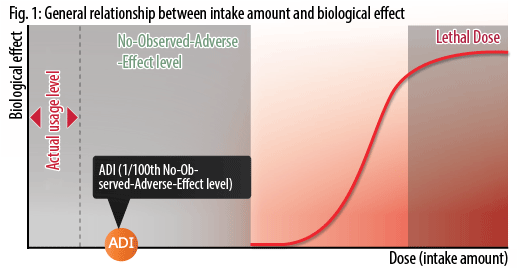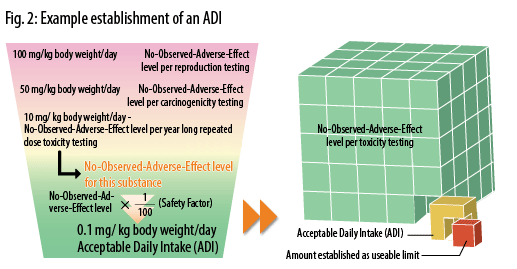Tokyo Food Safety Information Center » Tokyo Metropolitan Government food safety FAQ »Is it safe to eat food with pesticide residue on it?
Is it safe to eat food with pesticide residue on it?

When I hear about pesticide residues being detected which are higher than legal limits, I become worried.
I heard about a term called “ADI,” but I don’t know what that means.

Limits for pesticide residues are established based on the Acceptable Daily Intake (ADI) – that is, the amount of a substance which could be eaten every day and still not cause ill health effects.
The limits are set such that a normal person‘s total consumption of pesticides from foods such as rice, vegetables, and fruits will not exceed 80% of the ADI for pesticides. Accordingly, in a normal diet, pesticide residues will have no effect on health.


ADI is established after evaluations conducted by a Food Safety Commission comprised of experts and based on a variety of toxicity tests.
Toxicity testing is conducted with animals to determine safety. Chronic toxicity testing evaluates the influence of consuming a substance continuously for long periods of time. Teratogenicity testing evaluates the influence of a substance on a fetus when eaten by the mother. Genotoxicity testing looks at the influence of a substance on genes.
The results of these tests are used to evaluate the maximum amount of a substance which can be eaten and still not cause harmful health effects (No-Observed-Adverse-Effect level).
As the No-Observed-Adverse-Effect level is obtained through animal testing, it cannot simply be applied as-is to humans. Under the view that the difference in susceptibility between humans and animals is a factor of 10 and that the difference between individual humans due to factors such as sex and age is a factor of 10, these two figures are multiplied to reach a safety factor of 100 for human beings. The No-Observed-Adverse-Effect level reached through animal testing is thus divided by the safety factor of 100 to produce an ADI, the No-Observed-Adverse-Effect level used for people.
In turn, limits for residues on agricultural products are established for each type of pesticide based on ADI.
As the limits for pesticide residues are established based on the assumption that a person will ingest a given pesticide from multiple agricultural products, even if a person eats one food which exceeds the limit, there is no danger to health as long as they do not exceed the overall ADI. The state of pesticide residues detected from agricultural products is presented below.

